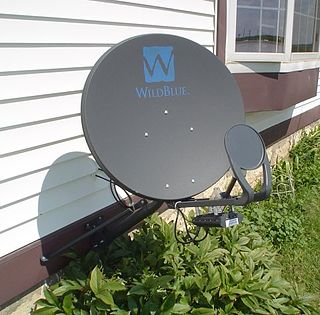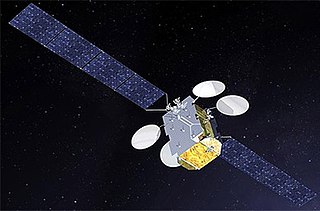
Satellite Internet access or Satellite Broadband is Internet access provided through communication satellites. Modern consumer grade satellite Internet service is typically provided to individual users through geostationary satellites that can offer relatively high data speeds, with newer satellites using Ku band to achieve downstream data speeds up to 506 Mbit/s. In addition, new satellite internet constellations are being developed in low-earth orbit to enable low-latency internet access from space.

SES S.A. is a Luxembourgish satellite telecommunications network provider supplying video and data connectivity worldwide to broadcasters, content and internet service providers, mobile and fixed network operators, governments and institutions.

Viasat is an American communications company based in Carlsbad, California, with additional operations across the United States and worldwide. Viasat is a provider of high-speed satellite broadband services and secure networking systems covering military and commercial markets.
HYLAS is a British satellite in geostationary orbit. HYLAS, which is an acronym for Highly Adaptable Satellite, is a communications satellite and was launched by the European Ariane 5 launch vehicle from the Guyana Space Centre at Kourou in French Guiana. It is located at the orbital location of 33.5 degrees west and will provide new and innovative services including High Definition Television (HDTV) and interactive satellite delivered broadband services. The satellite will help address the issue of poor broadband coverage in many parts of Europe which have less developed ground infrastructure.
O3b Networks Ltd. was a network communications service provider building and operating a medium Earth orbit (MEO) satellite constellation primarily intended to provide voice and data communications to mobile operators and Internet service providers. O3b Networks became a wholly owned subsidiary of SES S.A. in 2016 and the operator name was subsequently dropped in favour of SES Networks, a division of SES. The satellites themselves, now part of the SES fleet, continue to use the O3b name.

O3b is a satellite constellation in Medium Earth orbit (MEO) owned and operated by SES, and designed to provide low-latency broadband connectivity to remote locations for mobile network operators and internet service providers, maritime, aviation, and government and defence. It is often referred to as O3b MEO to distinguish these satellites from SES's forthcoming O3b mPOWER constellation.

KA-SAT is a high-throughput geostationary telecommunications satellite owned by Viasat. The satellite provides bidirectional broadband Internet access services across Europe and a small area of the Middle East, and additionally the Saorsat TV service to Ireland. It is positioned at 9°E, joining the Eurobird 9A Ku band satellite. KA-SAT was manufactured by EADS Astrium, based on the Eurostar E3000 platform, with a total weight of 6 tons. It was launched by Proton in December 2010. The satellite is named after the Ka band frequency, which is used on the spacecraft.
ViaSat-1 is a high throughput communications satellite owned by Viasat Inc. and Telesat Canada. Launched October 19, 2011 aboard a Proton rocket, it held the Guinness record for the world's highest capacity communications satellite with a total capacity in excess of 140 Gbit/s, more than all the satellites covering North America combined, at the time of its launch.

GSAT-11 is an Indian geostationary communications satellite. The 5854 kg satellite is based on the new I-6K Bus and carry 40 transponders in the Ku-band and Ka-band frequencies, which are capable of providing up to 16 Gbit/s throughput. GSAT-11 is India's heaviest satellite.
EchoStar XVII or EchoStar 17, also known as Jupiter 1, is an American geostationary high throughput communications satellite which is operated by Hughes Network Systems, a subsidiary of EchoStar. It is positioned in geostationary orbit at a longitude of 107.1° West, from where it is used for satellite internet access over HughesNet.
High-throughput satellite (HTS) is a communications satellite that provides more throughput than a classic FSS satellite for the same amount of allocated orbital spectrum, thus significantly reducing cost-per-bit. ViaSat-1 and EchoStar XVII do provide more than 100 Gbit/s of capacity, which is more than 100 times the capacity offered by a conventional FSS satellite. When it was launched in October 2011 ViaSat-1 had more capacity than all other commercial communications satellites over North America combined.
Intelsat 33e, also known as IS-33e, is a high throughput (HTS) geostationary communications satellite operated by Intelsat and designed and manufactured by Boeing Space Systems on the BSS 702MP satellite bus. It is the second satellite of the EpicNG service, and covers Europe, Africa and most of Asia from the 60° East longitude, where it replaced Intelsat 904. It has a mixed C-band, Ku-band and Ka-band payload with all bands featuring wide and C- and Ku- also featuring spot beams.
SES-17, is a high throughput all electric geostationary communications satellite owned and operated by SES S.A., and designed and manufactured by Thales Alenia Space. Launched on 24 October 2021 from Centre Spatial Guyanais (CSG), in Kourou, French Guiana by an Ariane 5ECA launch vehicle, SES-17 was positioned at 67.1° west in May 2022 and, after testing, became fully operational in June 2022.
The Geostationary Satellite for Defense and Strategic Communications is a Brazilian geostationary communication satellite that was built by Thales Alenia Space in France, it was placed in the orbital position of 75 degrees west longitude and will be operated by Telebrás. Telebrás selected Viasat as a partner to help build the associated ground system. The satellite was based on the Spacebus-4000 platform and its life expectancy will be 18 years.
PT Pasifik Satelit Nusantara (PSN) is a private Indonesian satellite telecommunications company.

Soyuz flight VS22 was a rocket launch conducted by multinational launch service provider Arianespace. It was the sixteenth launch of a Soyuz-ST-B launch vehicle, and the 22nd launch of a Soyuz-2 series launch vehicle from the Ensemble de Lancement Soyouz at the Guiana Space Centre. After two scheduling delays and a 33-minute logistical delay, the rocket lifted off on 4 April 2019, and successfully delivered to medium Earth orbit the final four satellites in the O3b broadband satellite constellation, which services Latin America, Africa, and Oceania. After four previous Soyuz flights delivered the constellation's first sixteen satellites, the launch increased the constellation's throughput by 26 per cent. The flight marked the second occasion in which two Soyuz-2 launch vehicles were launched on the same day, occurring hours after the launch of Progress MS-11 from the Baikonur Cosmodrome.
ViaSat-3 is a planned global constellation of three geostationary Ka-band communications satellites, the first of which was launched in 2023 by Viasat, Inc. The satellites are intended to provide broadband connectivity with speeds of 100-plus megabits per second to homes, business and enterprise internet users, commercial, government and business aircraft, as well as government and defense markets, maritime and oceanic enterprises in the Americas, Europe, the Middle East, Africa and Asia-Pacific.

Eutelsat Konnect is a geostationary communications satellite operated by Eutelsat. The satellite was designed and manufactured by Thales Alenia Space on the Spacebus NEO 100 platform, and was launched on 16 January 2020 on an Ariane 5 ECA. The satellite provides broadband internet and communications coverage to Europe and Sub-Saharan Africa.
Eutelsat 172B is a French communications satellite built by Airbus Defence and Space and operated by Eutelsat Communications. Launched on June 1, 2017, it has an expected service life of 15 years. Its orbit along with Eutelsat 172A allows it to cover the Asia-Pacific region, providing enhanced broadband and broadcast services.








